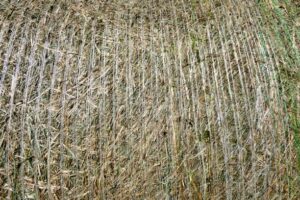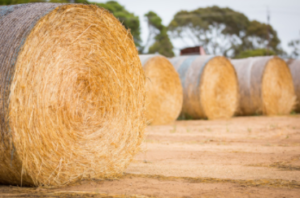Large round bales can be difficult to manage. Hay producers sometimes use poly or sisal twine as baling twine to help keep it together for transport and storage, its tensile strength being measured in kilograms of force.
Polypropylene
Round baler twine is an essential item for farmers, and there are various kinds available. Crafted from natural or synthetic fibers, twine is used to bind hay bales together while also being used to mend fences or reattach tractor parts. Durable and rot-resistant twine can even be preferred by some producers because it does not degrade in the field; however its nonbiodegradability may pose challenges; for instance refuse poly twine can remain littering feedlots and barns for decades because it won’t degrade.
 When purchasing twine, it is essential that you consider its manufacturer specifications, knot strength and tensile strength as measures of its suitability for your baler or application. By looking at these metrics you can gain more insight into its suitability.
When purchasing twine, it is essential that you consider its manufacturer specifications, knot strength and tensile strength as measures of its suitability for your baler or application. By looking at these metrics you can gain more insight into its suitability.
Some manufacturers provide various colors of twine to make it easier for you to select the ideal twine for your baler, including color charts in their manuals. You could use different hues for each paddock, cutting area, or field to keep track of your inventory – and avoid misusing twine or having to reload your baler more often than necessary.
Poly twine may be more expensive than natural twine, but its strength makes it ideal for small round or square bales. Some farmers have taken to using mini round bales as part of an innovative feed management strategy – leaving the twine on these mini bales allows livestock to graze through it all winter long; Round baler twine keeps livestock away from collecting in one area while simultaneously reducing field wear, compaction and improving spring regrowth.
Sisal
Sisal twine is an environmentally-friendly natural fiber commonly used to tie up bales of hay for decades. Biodegradable and treated to resist insects and rodents, this versatile twine boasts high tensile strength while remaining easy to use in traditional balers. Furthermore, being composed of renewable materials makes sisal safe for the environment while not harming crops in any way – plus there’s plenty of color options so that each bale stands out.
Agave sisalana, native to South America but widely cultivated throughout the world since ancient times, yields a stiff fibre used for rope and twine production; its versatility also extends beyond this use: papermaking, cloth manufacturing, paper weaving, shoe production, geotextile production as well as reinforcing composite fiberglass products such as rubber or concrete products as well as fermented and distilled products like mezcal production are just a few uses of its stiff fibres.
Sisal harvesting requires cutting and cleaning the leaves of the plant to remove its mucilage, known as decortication. For this process to work successfully, thousands of simple machines powered by diesel engines are spread throughout plantations to mechanically separate long fibrils from mucilage; then rinsed in water before bleaching in sunlight – an arduous and hazardous task for workers involved in decortication.
Round baler twine was Tanzania’s primary export during the 1960’s and accounted for more than 65% of foreign exchange. Unfortunately, however, the development of low-cost synthetic fibers caused sisal prices to plummet significantly; but some entrepreneurs saw an opportunity in it, including Mohammed Dewji of MeTL Group who saw a rebound. His company currently accounts for over one-third of total sisal production while earning healthy returns.
Utilizing the appropriate twine is integral to creating a sturdy bale. Too short a twine may fail during transport or storage, while too long can tear holes in plastic wrap. Selecting the ideal twine takes into account its tensile strength, durability and color when making this important decision.
Natural
Binding materials available for round bale production include twine, poly twine, and net wrap. Finding the appropriate binding material is key for successful baling season and should take into account factors like forage type, feeding plans and storage location.
Natural and synthetic twine are both commonly used to make hay bales. Natural twine is often knotless, made of long fibers treated to resist rot and rodents, and sold in various colors allowing you to easily identify individual bales. Furthermore, its knotless nature also makes natural twine an excellent option when used with metal ties.
Synthetic twine, more commonly referred to as poly twine, has become an extremely popular option within the hay industry for its durability and rot resistance. Unfortunately, its non-biodegradability means it may remain littering feedlots for years after being abandoned; some producers prefer organic binding materials like sisal twine instead of this synthetic option.
Historically, Round baler twine was classified based on its runnage (i.e. the amount of twine in each spool), providing producers an accurate way to calculate how much they needed for specific jobs. Unfortunately, today most manufacturers do not publicly state what runnage their products contain, creating additional confusion among customers.
Baler twine can be used not only to tie hay but also waste materials like newspapers and recyclables together for disposal. There are various different kinds of balers specifically designed to perform this task and twine is typically sold in suitable spools that fit these machines.
Most balers can handle both twine and net wrap baling material; however, some machines only support either twine or net wrap. Utilizing both may speed up baling while simultaneously increasing density levels and storage options. It is also safer and more cost-efficient.
Cost
Hay producers have several options when it comes to binding forage. These include twine, net wrap and wire. All three methods serve the same function – to hold together bales – but each has unique advantages and disadvantages; selecting the appropriate option depends on factors like production volume, baling machine model used and storage plans (indoor or outdoor).
Polypropylene twine may be expensive, but its durability makes up for any upfront expense with its excellent strength to weight ratio and long lifespan. Knotting is easy and it comes in different colors and lengths to suit every baling machine – plus ropes can even be formed out of it to increase breaking strength and durability! Some brands even feature UV stabilizers to limit degradation during use!
Coastal recommends selecting an American-made brand of twine for optimal cost per bale results. Many such products feature guaranteed feet per carton, providing you with full cartons without needing to constantly refill them. Be sure that whatever twine you purchase has both high press density and sufficient length in order to maximize savings per bale.
Some farmers use balers with Round baler twine arm systems equipped with twine twine arms for easier and faster baling production, saving time. But farmers should take care when wrapping bales that exceed 30 turns as this may result in premature moisture loss.
Other producers use net wrap balers, which form a tight seal around each bale, preventing moisture loss and improving baling efficiency. Furthermore, it keeps out insects such as weeds while simultaneously improving bale quality – also saving time on harvesting and transport.
No matter if you use twine, net wrap, or both for baling your hay, it is crucial that you test for moisture losses. To do this, take samples from each side and two from underneath of the bales for testing by measuring oven dry moisture content of samples taken on each side and from both ends, and measure oven dry moisture content of samples taken from both ends; this will allow you to determine if your baling system is operating as intended.
 Various silage film types are available, which you can use to wrap your bales. Different types come with different features. These include Polyethylene, Multiple layers, and Eco-friendly and cost-effective options. Here are some tips to help you choose the best film for your needs. Choosing the suitable silage wrap is an essential part of the baling process.
Various silage film types are available, which you can use to wrap your bales. Different types come with different features. These include Polyethylene, Multiple layers, and Eco-friendly and cost-effective options. Here are some tips to help you choose the best film for your needs. Choosing the suitable silage wrap is an essential part of the baling process.